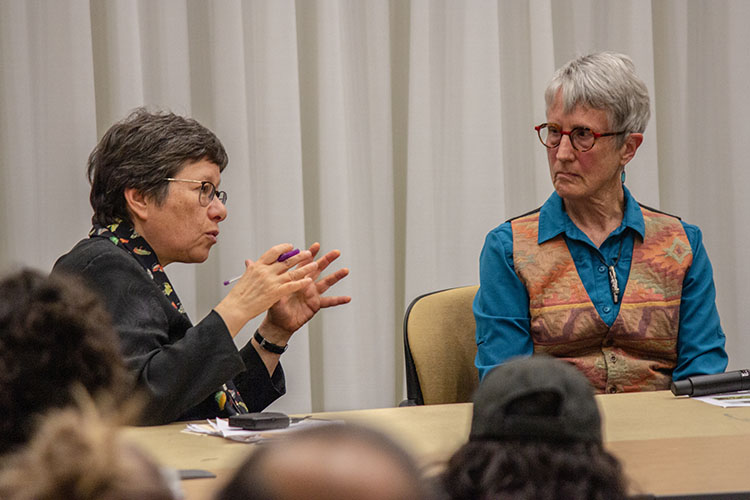
On a Wednesday afternoon near the end of the term, the lecture about to take place in Curtin 175 is standing room only and for good reason: it is not often that Donna Haraway and Anna Tsing visit UW-Milwaukee, as Haraway reminds us with her brief mention of last being at the Center when it was still called the Center for 20th Century Studies. As the next two hours unfold, Tsing and Haraway speak to and discuss questions surrounding their new term: the Plantationocene, which they define as the current landscape of conditions as shifted, altered, and impacted by the plantation, broadly understood. Together Tsing and Haraway weave a compelling and pressing argument about the increasing insecurity of the current global condition.
Tsing begins her portion of the lecture by noting that she remains committed to the concept of the Anthropocene and sees these two theoretical positionings as existing in harmony, not in opposition. She also reminds the audience that the ending –cene is meant to evoke the notion of a present condition, of a way of being, of a temporal moment. It strikes me as particularly accessible to non-anthropologists when Tsing mentions that –cene terms, though used in relation to temporality, are not tied to eras per se, but rather to sets of conjunctures. In short, –cenes are about the coalescing of contingencies into the present condition, not about epochs of existence. With the remainder of her time, Tsing lays out a well-founded and clear picture of how the plantation, which we consider a long-abandoned system, still shapes the Plantationocene of today: in systemic structures of oppression based in pseudoscientific depictions of race as biological; in industrialization’s eminence as the “natural” system of manufacturing and labor; in the factory system of exploited labor, a model inspired by the plantation’s unbound exploitation of land and people; in the disciplining of animals and plants in the agricultural and farm models of reproduction; and finally in the spread of pathogens and disease as a result of these disciplinary strategies. This conjuncture that Tsing and Haraway term the Plantationocene paints a grim picture of reality. And yet, Tsing voices her hope that this term enables us to avoid paralysis and instead move to action.
Haraway takes to the podium following Tsing’s explanation of the Plantationocene and suggests “attachment sites” as important facets of understanding the thick present of our current condition. Using the presumably innocuous example of a strawberry, Haraway reminds those of us with a penchant for the fruit that the very act of consuming commercially produced strawberries makes us accountable to the system that produced them in ways we were not before. Her argument, it seems, is that once you know something you cannot unknow it, and knowing that strawberry production in Monterrey Bay, California is emblematic of the Platationocene’s exploitative and ecologically damaging system of production means we must learn to account for and combat this particular attachment site. Her argument appears similar to other consumer-focused calls to environmental and ecological responsibility and is not, at first, compelling. Though consumers and individuals are responsible for upholding the Plantationocene to some extent, to forget that only 100 corporations are responsible for 71% of global emissions is to obfuscate the role of industrialization and its subsequent disciplining of plants in producing the Plantationocene. It is, however, in this moment of hesitation to accept Haraway’s example that I realize that Haraway’s argument, when made in concert with Tsing’s, is not necessarily about individual environmental guilt. Rather, it’s about the system as a whole. In essence, the synergy between Haraway’s emphasis on recognizing “attachment sites” as places where systems connect with individual lives and Tsing’s “bigger picture” of the Plantationocene as a present systemic condition coalesces into an argument much more refined than placing blame on individual consumers. Indeed, together their arguments push us to consider, and better, our current condition. It would seem I am not the only listener to make this connection as Tsing herself later admits she had never heard the term “attachment sites” before lunch the day of the talk and yet she feels it is a useful tool for operationalizing her own theoretical position.
The utility of the concept of the Plantationocene, and the urgency with which it arrives on the scene, is one laudable aspect of Tsing and Haraway’s discussion, but there is another, perhaps more easily overlooked facet of their discussion that catches my attention as an audience member and teacher: their commitment to theoretical and semantic accessibility. Inarguably titans of their fields, Tsing and Haraway are renowned for their theoretical work. Complex and at times difficult to follow in her writing, Haraway answers an audience question about the definition of “attachment sites” with a clear answer, one that even those of us without degrees in molecular biology can understand. Similarly, when pressed on the term Plantationocene, Tsing clearly defines for the audience the etymology of -cene and its link to the plantation. Indeed, when another audience member asks Haraway to explain what exactly she meant by “Malthusian” and why she focused a large portion of her time on refuting claims that their underlying argument was Neo-Malthusian, she and Tsing both give concise yet clear answers about Thomas Malthus’ nearly-eugenic “eat or be eaten” policy of population growth management and how their argument differs from it.
This approachability and accessibility are an impressive facet of an already compelling argument that takes into consideration both individual actors within networks, as well as the systems underlying those networks. As I leave the room to rush to my own lecture, I am left with a sense of respect and admiration rooted in a desire to attend to the messy complications of this, our Plantationocene.